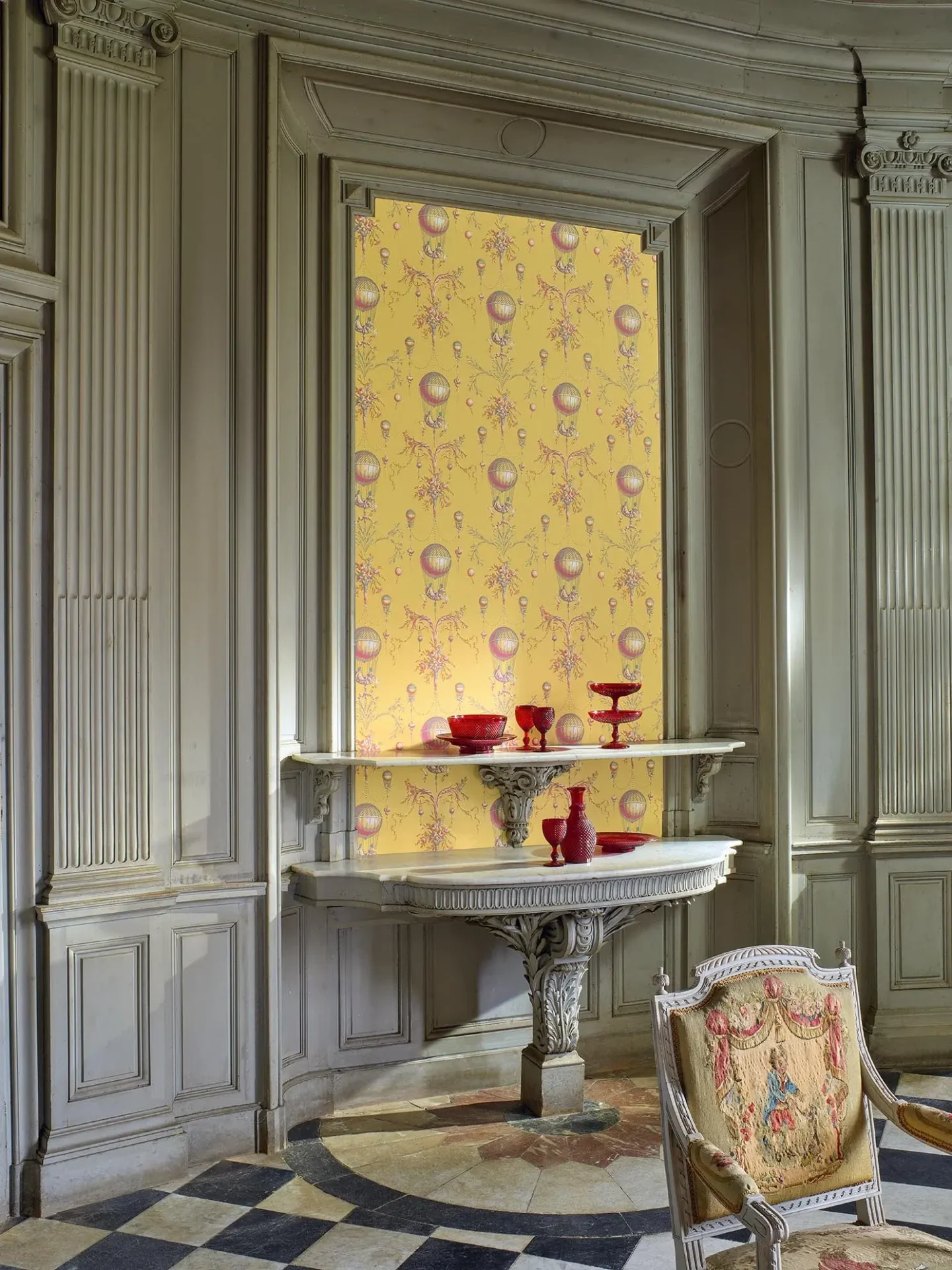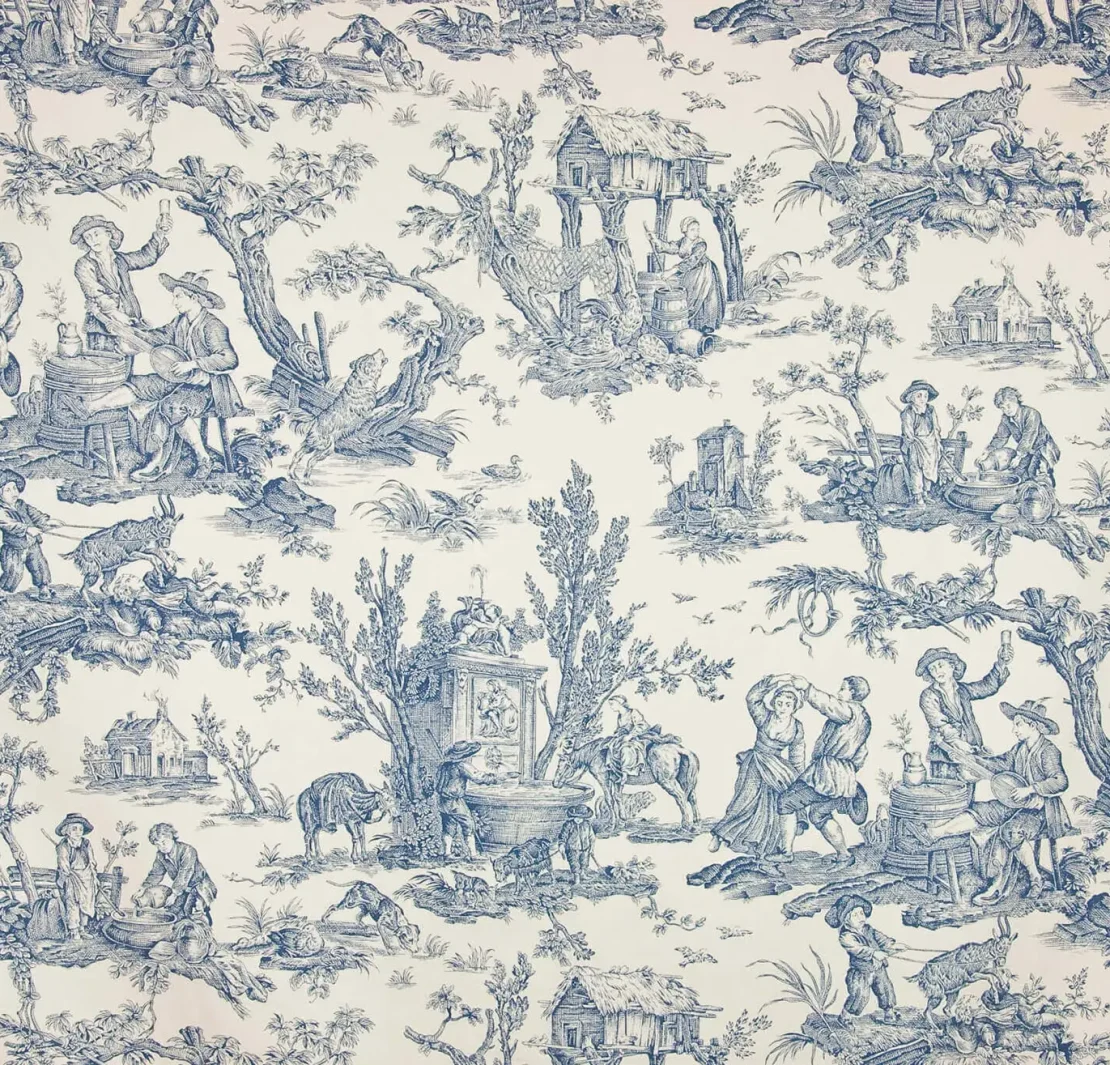Recently, I have developed a fascination with toile de Jouy, a design that you may recognize even if you are not familiar with its name or its historical ties to Oberkampf. For instance, think of the iconic pattern featured on Dior’s Book Tote. This toile de Jouy pattern was designed by Dior’s creative director, Maria Grazia Chiuri, to pay homage to the house’s heritage—Christian Dior’s first boutique on Avenue Montaigne prominently featured a pastoral toile pattern in its interior. Or recall the scene in the 1963 film Charade, where Audrey Hepburn’s character, left with only her Louis Vuitton luggage, retreats to a Parisian hotel room adorned with charming blue toile wallpaper. While the room isn’t ostentatiously luxurious, it exudes a captivating, understated elegance.

I remain deeply inspired by toile de Jouy for its ability to tap into one’s imagination. For me, observing a toile de Jouy within an interior feels like a journey through time. I am particularly enamored with the single-color designs by Jean-Baptiste Huet (1745-1811), which depict pastoral scenes and vignettes of French countryside life. These designs also feature exotic travel fantasies, allusions to European mythology, and nods to scientific advancements of the era, such as the first flight of the hot-air balloon (Montgolfière) in Versaille in 1783. Each piece is a captivating visual narrative, rich with historical and cultural references.
I carefully select and personally love every product featured on Leonce Chenal. If you buy through my links, I may earn an affiliate commission at no extra cost to you. Merci for your support <3
What is Toile de Jouy?
The word “toile” translates to “cloth” in French. “Toile de Jouy” specifically refers to linen or cloth from Jouy-en-Josas, a commune located in the southwestern suburbs of Paris, merely four miles from Versailles. Sophie Rouart, an art historian and archivist for Pierre Frey, explained to Architectural Digest that “toile de Jouy” has evolved into a generic term for any single-color printed fabric, regardless of its origin. Historically, however, toile de Jouy describes the fabrics produced by Christophe-Philipe Oberkampf in Jouy-en-Josas from 1760 to 1843. Nowadays, you can explore the rich history of this fabric at the Musée de la Toile de Jouy.
Interestingly, while printed toile fabric was first produced in Ireland in the eighteenth century, its popularity soared across France when the German-born Oberkampf opened his factory in 1760. The textile became known simply as “toile de Jouy,” and its influence quickly spread throughout Europe. Oberkampf collaborated with the prolific designer Jean-Baptiste Huet, who created several iconic patterns, including “Paul et Virginie” and “L’Escarpolette” (one of my favorite patterns). Although Huet’s classic, provincial aesthetic and single-color designs set the standard for toile, Oberkampf’s production predominantly featured floral and geometric motifs (over 30,000 polychrome floral patterns were created). Today, the narrative French country patterns of toile de Jouy are more widely remembered and preserved compared to their floral counterparts.
How to Decorate Your Home with Toile
There is a vast array of patterns to choose from, which can make selecting your favorite motif a delightful challenge—personally, I find them all quite stunning ;). You might prefer the pastoral scenes and vignettes depicting French countryside life, such as Pierre Frey’s “Mariage de Figaro” or “Scène de Campagne,” or you could be drawn to the polychrome florals like “Petits Appartements de la Reine,” or perhaps other patterns. Personally, I have a coup de coeur for the beautiful motif “La Roziere” (as seen in the photo below).

When it comes to decorating, I suggest steering clear of the “total look,” where every item features perfectly matching toile de Jouy textiles. Instead, consider using toile de Jouy selectively to create striking accents within a room. For example, it can be beautifully incorporated into an armchair—I’ve found a charming vintage Napoléon III armchair that I plan to reupholster when I relocate to Bordeaux. Or, you can introduce toile de Jouy to a specific room by adding Jean-Baptiste Huet’s provincial aesthetic and single-color designs on your walls, much like the Parisian hotel room where Audrey Hepburn’s character finds solace in the film Charade (1963).
Toile de Jouy also works wonderfully for curtains, carpets, a section of a wall, pillows, or even bed covers and sheets. For those looking to add a few classic, single-color toile de Jouy pieces to their homes, Cyrillus Paris and Zara Home offer a lovely selection of home decor items.
How to Incorporate This Design Into Your Wardrobe
Incorporating toile de Jouy into your wardrobe follows similar principles to those I’ve suggested for home decor. For vibrant toile patterns, consider small accessories such as scarves or tote bags. I highly recommend the exquisite creations from the French brand Inoui Editions, particularly the Square 130 Magnus Yellow scarf, with its striking blend of blue, lavender, and orange hues.
For tote bags, the Nomade Bag Barocco Black has caught my eye—perhaps it will become my next travel companion ;). If your budget allows, you might also look at the iconic Dior Tote Book, though I often wish for a version without the brand name displayed so prominently. This season, I’m enamored with the Sandro Kasbah toile de Jouy tote bag, a piece I highlighted in my previous post about what to wear in the south of France.
When it comes to larger items, I recommend classic, single-color toile de Jouy patterns that offer timeless elegance. For instance, pair Sandro flower print trousers with this chic double-breasted suit jacket for a sophisticated ensemble. Alternatively, consider a striking patterned maxi dress for a bold statement piece.
Et voilà! I hope you enjoyed reading this post and either discovered or learned more about this iconic French pattern. If you have any questions or thoughts, please share them in the comments below—I’d love to hear from you!
Bonjour! I’m Léonce, the editor of Leonce Chenal, a website dedicated to French style, beauty, and much more. I’m French and originally from a small town near Annecy. I started Leonce Chenal in 2018 to fulfill my passion for fashion and beauty while I was working as a data analyst in London. After living in Paris for a few years, I now reside in Amsterdam and will soon move to Bordeaux. I hope this space brings you the inspiration you need and infuses your life with a touch of joie de vivre. Merci for visiting! À bientôt, xo.

